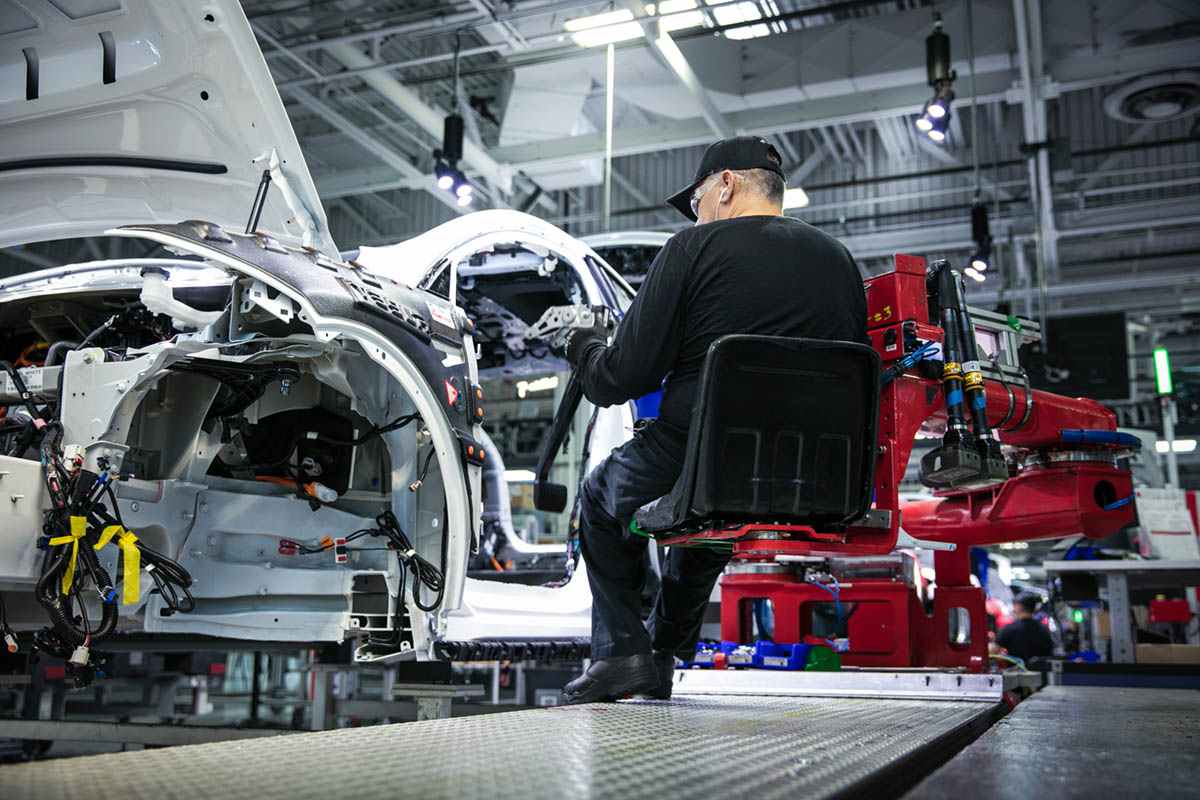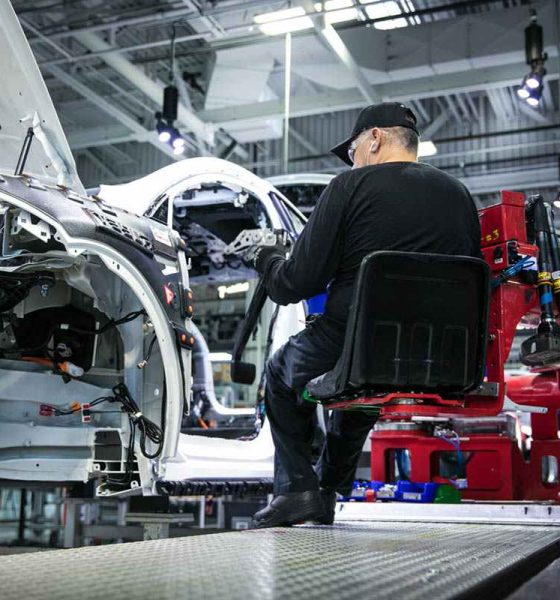

News
Tesla shares updates on workplace safety, CAL-OSHA investigation results
During the recently-held third quarter earnings call, CEO Elon Musk and VP for Environmental, Health and Safety (EHS) Laurie Shelby briefly discussed the safety initiatives that the company has implemented to keep its factory workers as safe as possible. In one of her remarks, the VP of EHS noted that it is an exciting time for Tesla today, as the company is making the “safest cars made by the safest people.”
In a recent blog post on Tesla’s official website, Laurie Shelby elaborated further on the company’s safety programs that were rolled out over the past year. Since joining Tesla back in October 2017, Shelby stated that her EHS team had grown to 250 employees, including 35 EHS staff in the Fremont factory alone. Several programs, some of which were teased during the earnings call, have also been started as part of Tesla’s pursuit of becoming the safest car factory on the market.
Back in June, for example, Tesla the started transitioning to a new occupational health clinic in the Fremont factory. These clinics are overseen by a leading California orthopedic surgeon specializing in the diagnosis and treatment of musculoskeletal injuries, which comprise around 85-90% of injuries in Tesla’s facilities. Shelby pointed out in her update that prior to its current system, Fremont’s health facility provided a lineup of services that was primarily focused on triage and first aid. With the newly rolled out clinic, Tesla’s workers can receive on-site, specialized care from full-time physicians who can provide medical assessments and immediate diagnosis.
As part of Tesla’s Early Symptom Intervention program, the company has also begun sending professional athletic trainers on the factory lines to identify potential injuries before they occur. These trainers are tasked with offering on-site evaluations and suggestions for improved ergonomic safety. So far, trainers have conducted more than 6,000 consultations with Tesla employees from the General Assembly, Seats, and Production Control lines, to name a few.
Perhaps most notable in the EHS VP’s update, though, was additional information on the CAL-OSHA investigation that was conducted earlier this year. Back in April, an expose by news agency Reveal based on accounts from alleged insiders and previous workers at Tesla accused the company of intentionally misreporting its injury rates. The expose blamed much of Tesla’s alleged safety problems on Elon Musk himself. At one point, for example, the publication noted that Tesla didn’t have enough hazard markings on the factory floor because “Elon does not like the color yellow.” Tesla promptly fired back, strongly denying the allegations in the report. A CAL-OSHA investigation into Tesla’s alleged malpractice eventually followed.
During the third quarter earnings call, Laurie Shelby noted that the CAL-OSHA investigation lasted four months, and the organization found no misreporting on Tesla’s part.

“The company here had a 4-month long Cal-OSHA investigation. And it basically proves that we are recording properly and doing as we should be. So it’s much different than what you would read about in the press,” she said.
In her safety update, Shelby added that after an extensive review of Tesla’s legally mandated records, injury logs, and safety policies, CAL-OSHA identified only two minor issues. One was an extension cord connected to a fan that created a potential trip hazard, and another was a date of injury that was incorrectly logged. Tesla promptly addressed the extension cord issue, while the incorrectly logged date of injury was immediately clarified and confirmed by a medical provider.
In true Tesla fashion, the company has ambitious goals when it comes to the safety of its employees. Earlier this year, for one, Shelby wrote a post announcing the company’s target of becoming the safest car factory in the world. The VP for EHS noted then that ultimately, workplace safety comes down to a combination of common sense, a culture that values safety, and a series of proactive preventive measures. If her recent update is any indication, it appears that over the past year, Tesla has started to make progress on all three fronts.
The full text of Tesla VP for EHS Laurie Shelby’s entire update could be accessed here.

News
Tesla FSD fleet is nearing 7 billion total miles, including 2.5 billion city miles
As can be seen on Tesla’s official FSD webpage, vehicles equipped with the system have now navigated over 6.99 billion miles.

Tesla’s Full Self-Driving (Supervised) fleet is closing in on almost 7 billion total miles driven, as per data posted by the company on its official FSD webpage.
These figures hint at the massive scale of data fueling Tesla’s rapid FSD improvements, which have been quite notable as of late.
FSD mileage milestones
As can be seen on Tesla’s official FSD webpage, vehicles equipped with the system have now navigated over 6.99 billion miles. Tesla owner and avid FSD tester Whole Mars Catalog also shared a screenshot indicating that from the nearly 7 billion miles traveled by the FSD fleet, more than 2.5 billion miles were driven inside cities.
City miles are particularly valuable for complex urban scenarios like unprotected turns, pedestrian interactions, and traffic lights. This is also the difference-maker for FSD, as only complex solutions, such as Waymo’s self-driving taxis, operate similarly on inner-city streets. And even then, incidents such as the San Francisco blackouts have proven challenging for sensor-rich vehicles like Waymos.
Tesla’s data edge
Tesla has a number of advantages in the autonomous vehicle sector, one of which is the size of its fleet and the number of vehicles training FSD on real-world roads. Tesla’s nearly 7 billion FSD miles then allow the company to roll out updates that make its vehicles behave like they are being driven by experienced drivers, even if they are operating on their own.
So notable are Tesla’s improvements to FSD that NVIDIA Director of Robotics Jim Fan, after experiencing FSD v14, noted that the system is the first AI that passes what he described as a “Physical Turing Test.”
“Despite knowing exactly how robot learning works, I still find it magical watching the steering wheel turn by itself. First it feels surreal, next it becomes routine. Then, like the smartphone, taking it away actively hurts. This is how humanity gets rewired and glued to god-like technologies,” Fan wrote in a post on X.
News
Tesla starts showing how FSD will change lives in Europe
Local officials tested the system on narrow country roads and were impressed by FSD’s smooth, human-like driving, with some calling the service a game-changer for everyday life in areas that are far from urban centers.

Tesla has launched Europe’s first public shuttle service using Full Self-Driving (Supervised) in the rural Eifelkreis Bitburg-Prüm region of Germany, demonstrating how the technology can restore independence and mobility for people who struggle with limited transport options.
Local officials tested the system on narrow country roads and were impressed by FSD’s smooth, human-like driving, with some calling the service a game-changer for everyday life in areas that are far from urban centers.
Officials see real impact on rural residents
Arzfeld Mayor Johannes Kuhl and District Administrator Andreas Kruppert personally tested the Tesla shuttle service. This allowed them to see just how well FSD navigated winding lanes and rural roads confidently. Kruppert said, “Autonomous driving sounds like science fiction to many, but we simply see here that it works totally well in rural regions too.” Kuhl, for his part, also noted that FSD “feels like a very experienced driver.”
The pilot complements the area’s “Citizen Bus” program, which provides on-demand rides for elderly residents who can no longer drive themselves. Tesla Europe shared a video of a demonstration of the service, highlighting how FSD gives people their freedom back, even in places where public transport is not as prevalent.
What the Ministry for Economic Affairs and Transport says
Rhineland-Palatinate’s Minister Daniela Schmitt supported the project, praising the collaboration that made this “first of its kind in Europe” possible. As per the ministry, the rural rollout for the service shows FSD’s potential beyond major cities, and it delivers tangible benefits like grocery runs, doctor visits, and social connections for isolated residents.
“Reliable and flexible mobility is especially vital in rural areas. With the launch of a shuttle service using self-driving vehicles (FSD supervised) by Tesla in the Eifelkreis Bitburg-Prüm, an innovative pilot project is now getting underway that complements local community bus services. It is the first project of its kind in Europe.
“The result is a real gain for rural mobility: greater accessibility, more flexibility and tangible benefits for everyday life. A strong signal for innovation, cooperation and future-oriented mobility beyond urban centers,” the ministry wrote in a LinkedIn post.
News
Tesla China quietly posts Robotaxi-related job listing
Tesla China is currently seeking a Low Voltage Electrical Engineer to work on circuit board design for the company’s autonomous vehicles.

Tesla has posted a new job listing in Shanghai explicitly tied to its Robotaxi program, fueling speculation that the company is preparing to launch its dedicated autonomous ride-hailing service in China.
As noted in the listing, Tesla China is currently seeking a Low Voltage Electrical Engineer to work on circuit board design for the company’s autonomous vehicles.
Robotaxi-specific role
The listing, which was shared on social media platform X by industry watcher @tslaming, suggested that Tesla China is looking to fill the role urgently. The job listing itself specifically mentions that the person hired for the role will be working on the Low Voltage Hardware team, which would design the circuit boards that would serve as the nervous system of the Robotaxi.
Key tasks for the role, as indicated in the job listing, include collaboration with PCB layout, firmware, mechanical, program management, and validation teams, among other responsibilities. The role is based in Shanghai.
China Robotaxi launch
China represents a massive potential market for robotaxis, with its dense urban centers and supportive policies in select cities. Tesla has limited permission to roll out FSD in the country, though despite this, its vehicles have been hailed as among the best in the market when it comes to autonomous features. So far, at least, it appears that China supports Tesla’s FSD and Robotaxi rollout.
This was hinted at in November, when Tesla brought the Cybercab to the 8th China International Import Expo (CIIE) in Shanghai, marking the first time that the autonomous two-seater was brought to the Asia-Pacific region. The vehicle, despite not having a release date in China, received a significant amount of interest among the event’s attendees.








